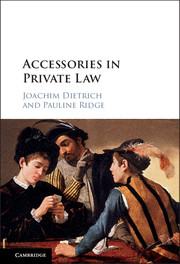12 - Conclusion
from PART III
Published online by Cambridge University Press: 05 February 2016
Summary
This book has explored the circumstances in which a person will be found liable in private law as an accessory to another's wrong. It has also sought to explain this liability. Why must an ‘accessory’ remedy the consequences of another's wrongdoing even though he did not personally commit the wrongful act? The answer, broadly speaking, is that knowing involvement in another's wrong is sometimes considered legally wrongful in itself. The accessory is liable for his own wrongdoing.
Accessory liability is a narrow basis of liability. This is, perhaps, unsurprising given the potentially onerous nature of the liability. Nor is accessory liability the sole basis for imposing liability on persons who participate in another's wrongdoing; consequently, the book has also explored the boundaries between accessory liability and such related liabilities.
This book does not argue that there is a single cause of action for accessory liability. The legal rules that determine accessory liability across private law are too complex and varied, even as to the form of liability itself, for that to be the case. Nonetheless, accessory liability in its various manifestations shares a deceptively simple analytical framework. Liability depends upon three factors: the commission of a wrong by another party; the accessory's involvement, through conduct, in the wrong; and the accessory's mental state at the time of such involvement. The content of the conduct and mental elements – and, consequently, the reach of liability – is a function of the purposes, values and historical development of the primary wrong. These three factors are legally significant in all instances of accessory liability, whether or not they are explicitly averted to.
Furthermore, the analytical framework is not static, but operates in a dynamic fashion. The normative question of whether a person is sufficiently linked to a wrong committed by another depends on the relative weight of, and interplay between, the three elements. The relational interplay of the elements can be discerned in the doctrinal formulation of specific liability rules and, sometimes, in their judicial application. In particular, it is the accessory's conduct and mental state, considered in combination and relative to each other, that may create a sufficiently strong participation link to the primary wrong for the accessory to be considered culpable in relation to that primary wrong.
- Type
- Chapter
- Information
- Accessories in Private Law , pp. 407 - 408Publisher: Cambridge University PressPrint publication year: 2016



